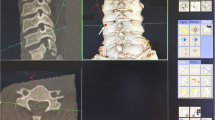Abstract
Purpose
The purpose of the present study was to evaluate the anatomic features of the cervical spine using computed tomography (CT) to select safer screw insertion techniques, particularly emphasizing the location of the transverse foramen.
Methods
Fifty patients who underwent multiplanar CT reconstruction were evaluated. There were 34 males and 16 females with an average age of 67 years. The parameters included the following measurements: foramen width (the size of the transverse foramen FW), foramen height (the size of the transverse foramen FH), pedicle width (PW), foramen angle (FA the position of the transverse foramen), pedicle transverse angle (PTA) and lateral mass angle (LMA).
Results
The mean FW ranged from 6.2 to 6.3 mm (n.s). The mean FH ranged from 5.0 to 5.7 mm, with significant differences between each vertebra, except for the FH between C4 and C5 and the FH between C5 and C6. The mean PW ranged from 5.4 to 6.1 mm. There were significant differences between each vertebra, except for the PW between C3 and C4 and the PW between C3 and C5. The mean FA ranged from 18.8° to 20.5°. There were significant differences between each vertebra, except for the FA between C3 and C6 and the FA between C4 and C5. The mean PTA ranged from 37.1° to 45.4°. There were significant differences between each vertebra, except for the PTA between C3 and C5. The mean LMA ranged from 1.0° to 5.3°. There were significant differences between each vertebra, except for the LMA between C4 and C5. The FW and FH exhibited no correlations with PW, PTA or LMA. FA was found to be positively correlated with both PTA and LMA. There was also a positive correlation between PTA and LMA.
Conclusions
We suggest that in cases in which pedicle screw insertion is difficult, lateral mass screws (LMS) can be inserted safely and longer sizes can be selected. In contrast, in cases in which LMS insertion is difficult, the insertion of pedicle screws can be performed relatively easy.


Similar content being viewed by others
References
Roy-Camille R, Saillant G, Lavile C, Mazel C (1989) Internal fixation of lower cervical spine by a posterior osteosynthesis with plates and screws. In: Lippicott JB (ed) The cervical Spine, 2nd edn. Cervical Spine Research Society, Philadelphia, pp 390–430
Jeanneret B, Magerl F, Ward EH, Ward J (1991) Posterior stabilization of the cervical spine with hook plates. Spine 16(suppl):S56–S63
An HS, Gordin R, Renner K (1991) Anatomic consideration for plate-screw fixation of the cervical spine. Spine 16(Suppl):S548–S551
Anderson PA, Henley MB, Grady MS, Montesano PX, Winn HR (1991) Posterior cervical arthrodesis with AO reconstruction plate and bone graft. Spine 16(Suppl):S72–S79
Abumi K, Itoh H, Taneichi H et al (1994) Transpedicular screw fixation for traumatic lesions of the middle and lower cervical spine: description of the techniques and preliminary report. J Spinal Disord 7:19–28
Yukawa Y, Kato F, Ito K et al (2009) Placement and complications of cervical pedicle screws in 144 cervical trauma patients using pedicle axis view techniques by fluoroscope. Eur Spine J 18:1293–1299
Schaefer C, Begemann P, Fuhrhop I et al (2011) Percutaneous instrumentation of the cervical and cervico-thoracic spine using pedicle screws: preliminary clinical results and analysis of accuracy. Eur Spine J 20:977–985
Abumi K, Shono Y, Taneichi H et al (2000) Complications of pedicle screw fixation in reconstructive surgery of the cervical spine. Spine 25:962–969
Cho KH, Shin YS, Yoon SH et al (2005) Poor surgical technique in cervical plating leading to vertebral artery injury and brain stem infarction–case report. Surg Neurol 64:221–225
Pal D, Bayley E, Magaji SA, Boszczyk BM (2011) Freehand determination of the trajectory angle for cervical lateral mass screws: how accurate is it? Eur Spine J 20:972–976
Cagnie B, Barbaix E, Vinck E et al (2005) Extrinsic risk factors for compromised blood flow in the vertebral artery: anatomical observations of the transverse foramina from C3 to C7. Surg Radiol Anat 27:312–316
Ebraheim NA, Xu R, Yeasting RA (1996) The location of the vertebral artery foramen and its relation to posterior lateral mass screw fixation. Spine 21:1291–1295
Ebraheim NA, Xu R, Knight T et al (1997) Morphometric evaluation of lower pedicle and its projection. Spine 22:1–6
Jeanneret B, Gebhard JS, Magerl F (1994) Transpedicular screw fixation of articular mass fracture separation: result of an anatomical study and operative technique. J Spinal Disord 7:222–229
Nishinome M, Iizuka H, Iizuka Y, Takagishi K (2012) Anatomy of subaxial cervical foramens, the safety zone for lateral mass screwing. Eur Spine J 21:309–313
Karaikovic EE, Daubs MD, Madsen RW et al (1997) Morphologic characteristics of human cervical pedicles. Spine 22:493–500
Reinhold M, Magerl F, Rieger M, Blauth M (2007) Cervical pedicle screw placement: feasibility and accuracy of two new insertion techniques based on morphometric data. Eur Spine J 16:47–56
Sakamoto T, Neo M, Nakamura T (2004) Transpedicular screw placement evaluated by axial computed tomography of the cervical pedicle. Spine 29:2510–2515
Zhao L, Xu R, Hu T et al (2008) Quantitative evaluation of the location of the vertebral artery in relation to the transverse foramen in the lower cervical spine. Spine 33:373–378
Ludwig SC, Kramer DL, Balderston RA et al (2000) Placement of pedicle screws in the human cadaveric cervical spine: comparative accuracy of three techniques. Spine 25:1655–1667
Chazono M, Soshi S, Inoue T et al (2006) Anatomical considerations for cervical pedicle screw insertion: the use of multiplanar computerized tomography reconstruction measurements. J Neurosurg Spine 4:472–477
Acknowledgments
No benefits in any form have been received or will be received from a commercial party related directly or indirectly to the subject of this article.
Conflict of interest
None.
Author information
Authors and Affiliations
Corresponding author
Rights and permissions
About this article
Cite this article
Nishinome, M., Iizuka, H., Iizuka, Y. et al. An analysis of the anatomic features of the cervical spine using computed tomography to select safer screw insertion techniques. Eur Spine J 22, 2526–2531 (2013). https://doi.org/10.1007/s00586-013-2883-5
Received:
Revised:
Accepted:
Published:
Issue Date:
DOI: https://doi.org/10.1007/s00586-013-2883-5




